
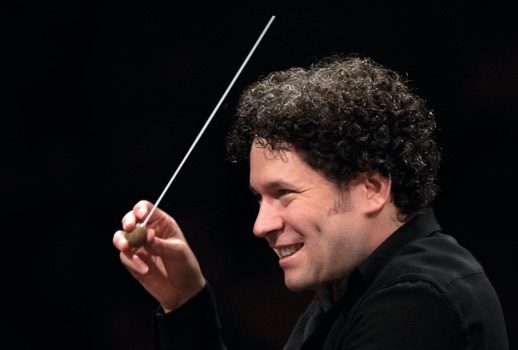
The annals tell about the first staging of Carmen in 1921 that featured a cast of nearly 500 and a legendary Die Walkure in 1938 that starred Maria Jeritza as Brunnhilde with her Valkyrie sisters on horseback riding down from the hills. I’m sure even back in the day someone always dropped a bottle of wine during the quietest moment of the evening so 15,000 people could enjoy listening to it roll down the concrete stairs to musical accompaniment.
Since taking the reigns of the Los Angeles Philharmonic in 2009 Gustavo Dudamel has kept that tradition alive starting with a Carmen in 2010 and adding, among others, Rigoletto, Aida, Turandot, and Traviata, and in 2013 a stellar reading of Verdi’s Requiem that was released on video and broadcast on PBS. This year’s offering was Tosca and it proved an creditable assignment for the gifts of our firebrand conductor, his players, and an able cast.
With all its pungent atmosphere it’s no wonder that that Tosca has gained a reputation as a conductor’s opera, in spite of providing three of the most exciting vocal and dramatic roles in the operatic canon. Hearing Maestro Dudamel have his way with the score certainly reaffirmed that label in spades. It was a passionate and finely judged reading right from those first crashing chords.
The glory of the LA Phil has always been the deep sonorities of its string playing and Sunday night was no exception. Fearless and striking in attack they blazed and simmered throughout the evening. They were joined by brass that were particularly pointed and a percussion and timpani that outdid themselves for virtuosity. I’m hard pressed to explain why after watching and hearing countless performances the Act III prelude with the synchronized church bells that Puccini meticulously used to represent a Roman morning suddenly made an indelible impression on me. The clarity, definition and variety of the tones were mesmerizing and Dudamel seemed to revel in the gentle cacophony.
The supporting cast was very good starting with the strong bass-baritone of Andrew Craig Brown as the escaped Angelotti who sets the plot in motion. The Sacristan’s duties inside the church were seen to by Valeriano Lanchas who refreshingly sang the part straight, and because of the concert staging, remained generally schtick-free. Character tenor Keith Jameson was a conniving Spoletta whose Latin was well versed and Metropolitan Opera Grand Prize winner Patrick Guetti made a favorable impression as Sciarrone. Boy soprano Grant Anderson displayed an enviable legato as the shepherd and since 2013 has amassed a surprisingly long list of appearances with LA Opera.
But the success of any performance of Tosca lies in its three principals. Falk Struckmann wielded his ample bass-baritone like a sledgehammer from the beginning of the evening and appeared later to be cannily covering for an indisposition by the end of Act II. In his defense we’re having brush fires so massive that the sky above my neighborhood was brown and yellow all day Saturday and I’m 30 miles away from the blaze.
Health advisories were issued for those of us who breath and the winds had mostly shifted Sunday. Still neither the air quality nor the sweltering temperatures were anything close to ideal for singing outside. Even if he did have to parlando a bit here and there it only added to his general air of menace which made him a lesson in professionalism.
I’m sure there’s a story behind how we got Russell Thomas at the ninth hour as the painter Cavaradossi instead of the originally announced Fabio Sartori but I think we were all the better for it. Mr. Thomas made a stunning Pollione for LA Opera this past December and he proved himself a highly skilled Puccinian. He flaunted an extraordinary breadth of phrasing and a solid legato line throughout the evening.
If he propels himself perhaps a little aggressively above the staff for effect he always remains true in pitch. He also showed the welcome propensity to a beautiful mezzo piano at many points in the score. Especially nice considering how most Cavarodossi’s simply bawl their way through the role without a second thought.
Now the libretto of Luigi Illica and Giuseppe Giacosa is so ripe with oaths, curses and reproachments of both a political and personal tack it probably hosts some of the juiciest lines of any opera this side of La Gioconda. How these lines are delivered, especially by the soprano singing Floria Tosca, is like a combination litmus test and mine field of adequacy on how all singers are judged in the role.
In the first interview with Scarpia in the church do you sing, shout, or scream,”Giuro!”(I swear!) after being confronted with the proof of your faithless lover? I could write a thesis on the various line readings for,”E avanti a lui tremava tutta Roma” ( And before him all Rome trembled) that she sings/speaks/sprechts after Scarpia’s death..
This was Julianna di Giacomo’s role debut as Floria Tosca and she has become a favored colleague of Maestro Dudamel. Her lyric-spinto has grown since that time to encompass surer projection at the top and a very well integrated baby chest at the bottom. The notes above the staff, especially the B’s and C’s were incredible strong and rang out freely without hindrance. All of her choices in the parlando passages were valid and showed proper attention to the composer’s markings as well as a modicum of interpretation. She also put plenty of bite into the text.
This being her first Tosca she can be forgiven for keeping her score close at hand. She wasn’t married to it per se but they were at the very least engaged. I’m happy to say that she and Thomas were so excitingly stentorian in their last act duet they elicited spontaneous applause before it was even over. They also landed the tricky a capella line up and down the staff and managed to finish in the correct key signature which is always a pleasure. Her “Vissi d’arte” showed rare poise and a long spun legato that built from a position of helplessness to a shattering climax crowning her performance. She was rewarded for her efforts with an enormous ovation from her home-town audience.
The Los Angeles Master Chorale and the Los Angeles Children’s Chorus did a superlative job in the Te Deum of the Act I finale and it was interesting to note that only the children were off book.
The staging, such as it was, took place on a long ramp at the back of the Bowl shell overlooking the orchestra. This was problematic in that, although it allowed the singers to remain closely linked to the conductor, our only real connection with the performers was through the Jumbotron’s that not only followed the singers but displayed the subtitles for those who needed them. I hope that things can be improved in this regard because I think the distance from the audience is deadly to our own involvement.
Then you add the layer of sound amplification necessary to project to the 10,000 patrons in the audience. All the singers not only sang in front of microphones but wore Janet Jackson-style over the ear body mikes with a little puffy yellow ball at their cheek. To say that the audio engineers of the Hollywood Bowl are the unsung heroes of every performance is an understatement. Cavarodossi’s offstage interjections during the torture were all well placed as was the cantata section from the courtyard.
My only disappointment was the Act I cannon fire since I attended a ‘greatest hits’ concert at the Bowl years ago where they used an actual one out back in the parking lot. Sunday’s was just a sound effect. Still with the nearly perfect balance between the chorus, the soloists, the organ and those bells if whomever was at the knobs happened to hit the gas pedal for those last few minutes, making all of our hair blow back momentarily, it was a stunner and I thank them.
Photo courtesy of the Los Angeles Philharmonic Association.














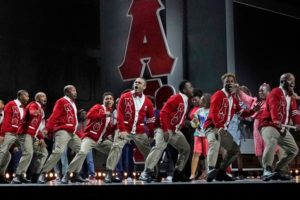
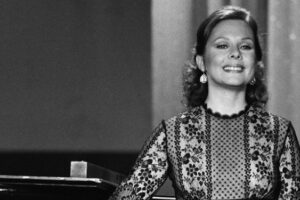
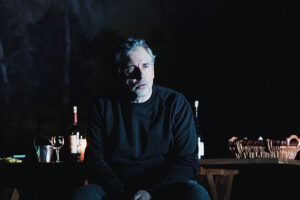
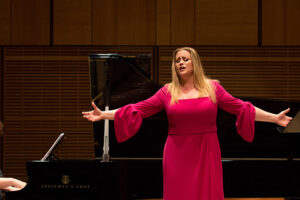





Comments